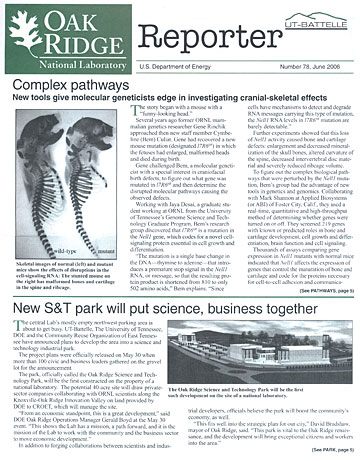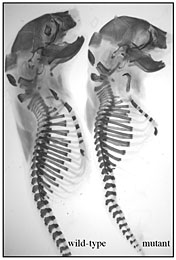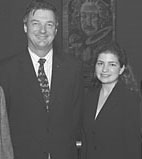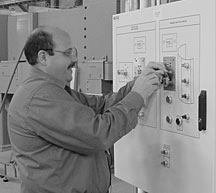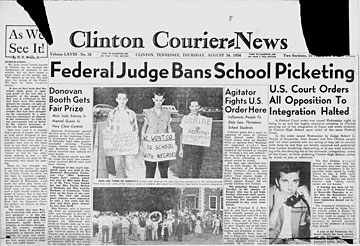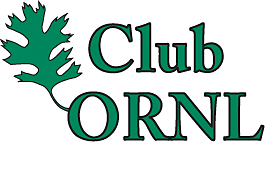 |
Number 78, June 2006
|
New tools give molecular geneticists edge in investigating cranial-skeletal effects
|
|
| Skeletal images of normal (left) and mutant mice show the effects of disruptions in the cell-signaling RNA: The stunted mouse on the right has malformed bones and cartilage in the spine and ribcage. |
The story began with a mouse with a “funny-looking head.”
Several years ago former ORNL mammalian genetics researcher Gene Rinchik approached then new staff member Cymbeline (Bem) Culiat. Gene had recovered a new mouse mutation (designated l7R66R) in which the fetuses had enlarged, malformed heads and died during birth.
Gene challenged Bem, a molecular geneticist with a special interest in craniofacial birth defects, to figure out what gene was mutated in l7R66R and then determine the disrupted molecular pathways causing the observed defects.
Working with Jaya Desai, a graduate student working at ORNL from the University of Tennessee’s Genome Science and Technology Graduate Program, Bem’s research group discovered that l7R66R is a mutation in the Nell1 gene, which codes for a novel cell-signaling protein essential in cell growth and differentiation.
“The mutation is a single base change in the DNA—thymine to adenine—that introduces a premature stop signal in the Nell1 RNA, or message, so that the resulting protein product is shortened from 810 to only 502 amino acids,” Bem explains. “Since cells have mechanisms to detect and degrade RNA messages carrying this type of mutation, the Nell1 RNA levels in l7R66R mutation are barely detectable.”
Further experiments showed that this loss of Nell1 activity caused bone and cartilage defects: enlargement and decreased mineralization of the skull bones, altered curvature of the spine, decreased intervertebral disc material and severely reduced ribcage volume.
To figure out the complex biological pathways that were perturbed by the Nell1 mutation, Bem’s group had the advantage of new tools in genetics and genomics. Collaborating with Mark Shannon at Applied Biosystems (or ABI) of Foster City, Calif., they used a real-time, quantitative and high-throughput method of determining whether genes were turned on or off. They screened 219 genes with known or predicted roles in bone and cartilage development, cell growth and differentiation, brain function and cell signaling.
Thousands of assays comparing gene expression in Nell1 mutants with normal mice indicated that Nell1 affects the expression of genes that control the maturation of bone and cartilage and code for the proteins necessary for cell-to-cell adhesion and communication. The reduction of Nell1 activity in l7R66R reduced the expression levels of 13 genes in the head and 23 genes in the body of mouse fetuses.
“These findings, recently published in Human Molecular Genetics (March 2006), are very significant in understanding human skeletal defects,” Bem says. “Earlier studies have shown that in some children with craniosynostosis (CS), a condition wherein the skulls of young children fuse early and restrict the growing brain, the NELL1 gene is over-expressed. When mice over-expressing Nell1 were generated at UCLA, the young mutant mice also developed CS, demonstrating that the mouse can accurately model the functions of human NELL1.”
|
The findings may lead to identification of Nell1 mutations in patients with skull and spinal problems. |
The novel finding by Bem’s lab—that losing Nell1 function enlarges the skull and alters the spinal column curvature—may lead to the identification of Nell1 mutations in patients with skull and spinal curvature problems.
“Medical research on the skull and spinal column is extremely difficult to conduct in people, hence mutant mice like the ORNL l7R66R (now called Nell16R) mutation are valuable tools in unraveling the basis of these human disorders and designing future therapies or treatments,” Bem says.
Bem’s group has started a new collaboration with Kang Ting’s lab at UCLA to further explore the role of Nell1 in the early development of the skull. Ting’s group made the initial discovery connecting human NELL1 with CS and generated the Nell1 over-expressing transgenic mouse. Both the ORNL and UCLA mutant mice are necessary to obtain a thorough analysis of Nell1-mediated pathways.
ORNL has shipped Nell16R mice to UCLA for further studies. Bem’s lab will continue to use the Nell16R mice in investigating Nell1-mediated biological pathways in the spine.
In people, spinal curvature defects can cause a host of health problems, including cardiovascular-pulmonary complications. Abnormal spine curvatures or compressions of the spine, such as those seen in Nell16R, can dramatically alter the ribcage, which in turn can adversely affect lung and heart development and function. Furthermore, understanding the role of Nell1 in making cartilage in the intervertebral discs may ultimately be applied to treatments of spinal disc degeneration—a significant source of chronic and debilitating back pain in the elderly.
Models for how Nell1 interacts with other genes to control developmental pathways in the skull and spinal column have been constructed and will provide the basis for future experiments.
“The mouse with ‘a funny-looking head’ has indeed opened up a lot of new doors in biomedical research,” Bem says.—B.C. 
|
|
The Oak Ridge Science and Technology Park will be the first such development on the site of a national laboratory. |
The central Lab’s mostly empty northwest parking area is about to get busy. UT-Battelle, The University of Tennessee, DOE and the Community Reuse Organization of East Tennessee have announced plans to develop the area into a science and technology industrial park.
The project plans were officially released on May 30 when more than 100 civic and business leaders gathered on the gravel lot for the announcement.
The park, officially called the Oak Ridge Science and Technology Park, will be the first constructed on the property of a national laboratory. The potential 40-acre site will draw private-sector companies collaborating with ORNL scientists along the Knoxville-Oak Ridge Innovation Valley on land provided by DOE to CROET, which will manage the site.
“From an economic standpoint, this is a great development,” said DOE Oak Ridge Operations Manager Gerald Boyd at the May 30 event. “This shows the Lab has a mission, a path forward, and it is the mission of the Lab to work with the community and the business sector to move economic development.”
In addition to forging collaborations between scientists and industrial developers, officials believe the park will boost the community’s economy, as well.
“This fits well into the strategic plan for our city,” David Bradshaw, mayor of Oak Ridge, said. “This park is vital to the Oak Ridge renaissance, and the development will bring exceptional citizens and workers into the area.”
Boyd agreed, saying that the development will help companies access technologies developed at ORNL and create new jobs.
Gerry Goss, founder of Pro2Serv, a local engineering firm, announced that it will build a 100,000-square-foot building in the park. ORNL Director of Technology Transfer and Economic Development Alex Fischer added that Holrob Investments LCC intends to build a similar facility during the park’s first phase of construction. Construction on the Pro2Serve facility will begin this summer.
“In the years ahead I expect this park will be home to universities, large established companies and small start-up companies,” ORNL Director Jeff Wadsworth said. “Each can benefit from the unique resources we have in Oak Ridge.”
UT-Battelle and its partners envision a facility that will house private and developmental research facilities, prototype manufacturing facilities, technology incubation spaces for commercializing products, engineering support services and high-tech and science-based companies.
The Oak Ridge Science and Technology Park will follow the Association of University Research Parks standards and look to the Stanford Industrial Park as a model. It will be the first AURP-standard park in
Tennessee.—Ashley Yeager 
ORNL’s Performance and Development System has been revised for the FY 2006 evaluation process. PADS, which since
FY 2000 used seven ratings and evaluated individual job performance for salaried employees from 1 to 7 (highest), has been changed to use only four ratings in FY 2006.
“The change in performance ratings was approved last fall by the ORNL Leadership Team. The new ratings are the result of an analysis of industry benchmarking data and best practices for performance management systems”, says Human Resources’ Mike Willard. “Most of the other best practices that were identified have been previously incorporated into PADS,” Mike adds.
“The new four-ratings scale was successfully piloted in PADS in conjunction with the FY 2005 performance assessment process and evaluated during the first quarter of
FY 2006,” says Mike, who manages HR’s Compensation & Information Systems group.
In another change in policy for the upcoming ratings period, all Lab salaried staff will be required to enter performance plans and assessments into the electronic PADS.
“In FY2005, more than 80 percent of the Laboratory staff used the electronic PADS for performance management. And, while we don’t anticipate a significant impact on the remaining 20 percent of the Lab staff who haven’t used PADS in the past, we will be providing demonstrations, training and other support as needed to facilitate their transition,” Mike says.
The new ratings for FY2006, from the highest to lowest, with their corresponding definitions are
Distinguished Contribution (DC) — Performance was the very best we can expect of an individual in a given position. Performance has been consistently far beyond expectations and is so high as to uniquely differentiate him/her from virtually all others performing similar work at the Laboratory. This rating is intended to recognize the top 10 percent of staff.
Outstanding Contribution (OC) — Performance was outstanding and significantly exceeded expectations in accomplishing all job duties and performance objectives during this review period.
Full Contribution (FC) — Performance was full, complete and met or exceeded the Laboratory’s high standards and expectations of a fully qualified and experienced individual in a given position. The majority of Lab staff should receive this rating.
Not Fully Contributing (NF) — Currently not meeting some or all performance expectations. Performance improvement is necessary to meet the expectations of a fully qualified and experienced individual in a given position. “NF” ratings will include an individual performance improvement plan.
Two additional codes are available to address situations where employees cannot be reasonably assigned one of these four ratings. Progressing (PR) may be used when an employee is relatively new to the Lab, or is in a new job as a result of a recent change in jobs, but is performing as expected in the new job. Not Rated (NR) may be used when new employees are hired near the end of the performance period, or for employees who are absent for the majority of the performance period, and assigning a performance rating is not feasible.
Mike notes that performance management is a shared responsibility between managers and employees.
“Performance management has historically been viewed as an HR process. To be successful in driving business performance, line management at all levels must take ownership and ‘drive’ the process. Employees must also be more educated about and involved in the goal-setting process, which begins with the development of their individual performance plans,” he says.
To facilitate the increased use of PADS, HR is planning additional system enhancements to address identified user issues and suggestions. HR Managers (HRMs) are also available to assist with communicating and preparing to use the new performance ratings. Contact your HRM or Mike Willard if you have questions or need additional information.—B.C. 
Dana C. Christensen has been named Associate Laboratory Director for Energy and Engineering Sciences. He will oversee the directorate—comprising three divisions and seven major programs— charged with developing technologies toward diversified energy production methods, improved energy transmission, reduced energy consumption and energy security.
He comes to ORNL from the Los Alamos National Laboratory, where he filled the position of principal deputy associate lab director for threat reduction.
ORNL Director Jeff Wadsworth says that Dana brings broad management and program leadership experience in materials science, nuclear energy, fossil and renewable energy, nuclear materials processing and scientific research to the EES Directorate.
“Dana joins ORNL at a time of extraordinary opportunity for energy and engineering research and development. Leadership in energy research and development is critical to the future of ORNL and the nation,” Jeff says.
Dana has more than 15 years of experience managing major facilities, programs, and line organizations as director of the Nuclear Materials Technology Division at LANL and principal deputy associate director for the Energy and Environment Directorate at Lawrence Livermore National Laboratory.
He studied chemical engineering at New Mexico State University, where he earned undergraduate, M.S. and doctorial degrees. He holds an Executive Master’s degree in Business Administration from the University of New Mexico.
Dana succeeds Ted Fox, who served as the EES’s interim director for the past seven months. Ted will resume his position as director of the Engineering S&T Division.
Dana and his wife, Betsy, are currently relocating to the Oak Ridge area. They have two sons and a granddaughter. —Ashley Yeager 
 |
 Employee Engagement Survey
follow-up begins
Employee Engagement Survey
follow-up begins
You took the survey, so now what? Plans for ORNL Employee Engagement Survey follow-up activities are already in place.
The overall Lab response to the May survey was 80 percent, “an excellent response for the first year,” says Organizational Development and Training Manager Debbie Stairs.
On June 19, the Gallup organization, the group that conducted the survey, will provide an in-depth analysis of survey results to the Leadership Team. All managers will be invited to participate in “ORNL Employee Engagement Process Manager Training” June 20 through mid-August. In these two- to three-hour sessions, managers will receive their own work group’s scorecards and results, as well as an analysis of what the results mean. They will also explore ways to share survey results with their work groups and identify best practices and actions for improvement, based upon their results.
Between June 20 and Sept. 30, “Team Feedback and Action Planning” will occur. During this time, all employees should receive results for their work groups, their directorates and the Laboratory overall.
“To those who responded, thank you for contributing your two cents. Look for your change,” Debbie says.
 Getting attention on competitiveness
Getting attention on competitiveness
Knoxville was the destination for a significant sector of the physics community in May, when the American Physical Society’s Division of Atomic, Molecular and Optical Physics came to town with 800 researchers and a smattering of Nobel laureates for their biannual conference.
The gathering generated an itinerary of Spallation Neutron Source tours from many interested attendees. One visitor was Michael Lubbell, a professor of physics at City University of New York and the APS’s director of public affairs.
Lubell received a personal SNS tour from a former student, Stuart Henderson, who has done well: Stuart will lead the SNS’s newly formed Research Accelerator Division. Lubell also toured the Holifield Facility’s newly revamped Multicharge Ion Research Facility.
He also spoke, but not strictly about physics. His topic, “Science on the National Agenda: The Road Back,” was a recounting of the work he, ORNL’s Jeff Muhs and a host of other science-attentive folks in Washington did to convince the nation’s leaders that U.S. preeminence in science and technology is threatened.
He had the numbers, which reflected flat funding of basic research, growing trade deficits in advanced technology products and a growing offshore research capability as other nation’s emulate America’s success.
One needed fix Lubell cited was the 1952 Immigration Act, which requires visiting foreign students to sign a statement that they will return to their home countries. International students increasingly return home with their talents, and that’s not currently seen as to our advantage.
“It’s nuts,” Lubell said.
Such warnings were instrumental in the formation of the American Competitiveness Initiative, the administration campaign mentioned in President Bush’s State of the Union address that seeks to revitalize a commitment to science research and education that has waned over the last two decades.
“It’s the fastest any issue has gone from zero to the front,” a White House official told Lubell.
 One key: The next generation
One key: The next generation
“If you want to do neutron science, come to Oak Ridge. We are the best in the world. That’s the standard we are going by.”
Such was the tone set by ORNL Director Jeff Wadsworth, who gave his State of the Laboratory talk on May 9 as part of the Friends of ORNL and American Museum of Science and Energy’s Community Lecture Series.
|
|
| Jeff Wadsworth and this year’s UT-Battelle Scholarship winner, Jana Black. |
Jeff summarized progress in the Lab’s new programs, including the Spallation Neutron Source, the Nanoscience Center and the National Center for Computational Sciences. He weighed that progress against the increasingly global economy and the U.S. challenge to preserve its technological and economic leadership.
“People around the world are trying to stay ahead in nano-info-bio,” said Jeff, who saw some of the national laboratories’ growing competition in his travels over the past year.
It so happened that the State of the Laboratory talk presented an opportunity to have Jeff’s photo taken with a representative of the future: This year’s UT-Battelle Scholarship winner, Jana Elisabeth Black. The Oak Ridge High School senior, the daughter of Health Services’ Dr. William and June Black, is University of Tennessee-bound with a $5,000-a-year scholarship over four years.
Jana didn’t stay for the speech, however. She had an advanced placement final exam the next day and returned home to study. No one objected.
The instruments will be where the science happens at the Spallation Neutron Source
OKen Herwig walks down the hall with his nine o’clock appointment.
“So Ken,” says a passing colleague, “I hear you are going to be getting some neutrons soon.”
It is 10:30 in the morning, a typical time for a coffee break. But “getting neutrons” is not your typical coffee-break chatter—unless you employ these neutrons as detectives.
That is what makes Ken Herwig’s job so important. As an instrument specialist at ORNL, Ken’s specialty lies in trying to design an instrument to make neutrons act like detectives, to probe the molecular world. It is the instruments he builds that allow scientists to “see” just how our world’s basic building blocks behave.
|
|
| The SNS’s Ken Herwig flips, for the first time on May 22, a switch that opens a shutter, sending neutrons to the backscattering spectrometer. |
SNS Director Thom Mason says Ken was one of the first SNS scientists hired, which allowed him to get moving early. Now it’s Ken’s time to “get some neutrons,” and on May 22, Ken’s backscattering spectrometer got its first hit of the subatomic particles.
The backscattering spectrometer is a device that measures how neutrons change in energy as they interact with different materials. Ken’s journey to getting neutrons began eight years ago when an SNS advisory committee, which included scientists from universities and other national laboratories, developed a set of scientific goals for future research. The committee asked Ken to draft a plan for the spectrometer so that scientists would be able to do research and ultimately peer deeper into the interactions of the molecular world.
Working with a designer and engineer on how to build his instrument, Ken created a sketch. Now, six years after finishing the design for the spectrometer, Ken has completed each phase, from development to installment and review. So that is why the opening of the shutter last month was such an “exciting”—in his words— moment for Ken and his colleagues.
The SNS’s first neutrons mean Ken is ready to start the commissioning phase of the backscattering spectrometer. He will run the first basic experiments and measurements on the instrument, ensuring that it performs according to his design. And, because that phase lasts three to six months, the instrument scientist is just a few months away from “doing science on the instrument,” he says. “And that is the really exciting payoff part at the very end.”
After Ken finishes the initial scientific calibrations on the spectrometer, he will be ready to make his instrument available to researchers from around the world, which is a major goal for the SNS.
|
“The first things you want to know if you are going to model a material are what’s in it? How far apart are they? Those are great clues as to what is going on in there.” |
Ken says, “The instrument scientist leads these scientists, providing expertise on operating the SNS instruments. They do the scheduling, they help plan experiments, they help analyze the data and understand what it means.” Ken will participate in communicating about the instrument, writing papers and attending conferences, as well.
When Ken can finally turn his neutrons into material detectives, he will be working with the most powerful neutron backscattering instrument in the world.
“One of the main missions, if you really want to punch it down into its basics, is that the Spallation Neutron Source is really designed for looking at materials,” the instrument scientist says.
“Let’s use a crystalline structure, like many metals or even table salt, as an example. The building blocks are atoms,” he says, “and you are interested in how far apart atoms are.”
The atoms form a lattice structure, a three-dimensional cube-like object. Ken says that the cubes, or square blocks, are strung together in a repeating pattern so they build one on top of the next. With them, “you can assemble a macroscopic structure that you can hold in your hand,” he says. “So we try to understand where the atoms are in this one block and what the distances are that separate the atoms from one another.
“Those are the first thing you want to know if you are going to model a material: What’s in it? How far apart are they? Those are great clues as to what is going on in there.”
Welds are a prime example of a crystalline structure that scientists will study with neutrons, using Ken’s instrument. The welded region, where two metals are heated, melted together and then quickly cooled, has a different crystal, or cube-like, structure than the original two metals. The heated region may have more or less carbon, Ken explains, but, more importantly, as the metals that were melted cool, the atoms in those regions may not get to go back quite the right distance apart as they were in the original structure.
Ken calls that a residual strain, something scientists can measure using neutrons. The neutrons are sent into the weld region for the backscattering spectrometer to find out the distance between the atoms; scientists then compare that distance between atoms with the distance between atoms of the original metal. That change in atomic spacing reveals to the researchers the characteristics of the weld, specifically if it is prone to cracking.
“So that’s a kind of structural measurement, and neutrons are good for particular classes of that, and they are very complementary to X-rays, which can also measure those properties,” Ken says.
“The other thing neutrons are good at measuring is dynamics, and by that I mean, how things are moving inside this material.”
Even when putting a crystal together, the atoms are not just stuck one next to the other, Ken says. They are actually vibrating, which is very important because it tells scientists how sound and heat travel through the cube-like crystal. “So one atom moves and then the one next to it, and then the one next to that one, and you get a wave that travels through the crystal. We can measure that movement with neutrons. Those are known as inelastic measurements.”
Ken’s backscattering spectrometer is the highest resolution inelastic instrument at the SNS, which means that it can measure the most minute energy changes in a neutron—a change as small as 1/1000 of a joule. So essentially, Ken is working on a scale that is 50,000 times smaller than the diameter of a human hair.
“One way to think about it is to picture the atoms and the neutrons as billiard balls,” says Ken. “The atoms are moving on one end of the billiard table and the neutrons are directed towards them along a defined direction and at a determined speed. When the neutron billiard ball collides with the atom billiard balls, it may change direction and speed. If I can measure the change of this direction and speed, I learn something about how the atom billiard balls are moving.”
Now only a few months from employing these neutron detectives, Ken and his fellow materials scientists are closing in on the molecular world and taking giant steps toward understanding the invisible interactions that control the properties of current and future advanced materials.—Ashley Yeager
Ashley Yeager is this summer’s intern from the University of Tennessee’s science communications program. 
Martin Keller will join the Environmental Sciences Division as deputy division director for Microbial Systems Biology, effective in July. He is currently director of New Technology Development and High Throughput Screening at Diversa Corporation.
The Materials S&T Division’s Amit Goyal recently received the 2006 Rochester Distinguished Scholar Medal from the University of Rochester and addressed the graduating class at the doctoral commencement ceremony. Amit also has received a 2006 American Society of Metals-Indian Institute of Metals lectureship award. Visiting lecturers are ambassadors-at-large of ASM International to the materials community in India.
Steve Allison, Engineering S&T Division, has been elected ISA (Instrumentation Society of America) Fellow “in recognition of the development of a new type of thermometry based on fluorescent materials in conjunction with fiber optics.”
Members of the Environmental Sciences Division’s DoD Technical Support group received an award recently from officials at Dover Air Force Base, recognizing their role in the Delaware base’s environmental restoration program and remedial action technologies. The ESD team at Dover includes Aleisa Bloom, George DeLong, Bill Ahlers and Dwight Robertson.
Narendra Dahotre of the Materials S&T Division’s Materials Processing group recently received a 2006 University of Tennessee Chancellor’s Research and Creative Achievement Award. Narendra has been instrumental in the initiation of materials laser processing within MSTD.
Andre Desjarlais has been elected to the chairmanship of the American Society for Testing and Materials Committee for C16 on Thermal Insulation. Andre is the leader of the Building Envelopes group in the Engineering S&T Division. 
UT-Battelle helps memorialize an early victory against school segregation
UT-Battelle is helping a Clinton group establish a museum to memorialize a time when the small East Tennessee town was in the forefront of a shift in America’s racial policies and, consequently, in the national spotlight. The ORNL contractor is supporting the project with approximately $50,000 in corporate gifts.
ORNL’s Creative Media group, with support from UT-Battelle, is copying historical newspapers and documents for the Green McAdoo Cultural Center Museum, planned for the site of the old Green McAdoo School in Clinton. Green McAdoo, until 1956, was the city’s “colored” high school.
The story began in the early 1950s, when a local group challenged Clinton school segregation policies with a lawsuit. The lawsuit was one of a number of efforts to dismantle Jim Crow statutes across the country. Later, the historic 1954 Supreme Court Brown vs. Board of Education decision in effect outlawed school segregation.
|
|
| UT-Battelle’s help with the Green
McAdoo Cultural Center Museum has included
sorting through and electronically imaging a collection of 50-year old newspapers from key periods in the Clinton desegregation uproar. |
It would take years for integration to actually take hold, but one day in 1956 a dozen African American students, with the backing and protection of white civic leaders including the pastor of the town’s biggest Baptist church, arrived at the all-white Clinton High School to enroll.
The few protesters quickly skulked away, but the long-planned procession drew national media attention. By the weekend disapproving locals and agitators from afar had congealed into a mob. “Outsiders” fanned the flame. A local man, John G. Moore, who was among several deputized in an attempt to keep order, wrote that on the historic Saturday night of Sept. 1, 1956, “there were not many in the crowd that I recognized.”
State troopers arrived in the nick of time. The barely averted melee led to arrests and trials. Although the school was integrated, the unrest continued as Clinton became a symbol of the transition from racism to equality, culminating in a Saturday-night bombing of Clinton High School in 1958. That unsolved crime might have swung attitudes away from the segregationists. Even a right-wing commentator of the era, Westbrook Pegler, raised money nationally to rebuild the school.
Moore writes that up until the turmoil race relations in the area had been “exemplary.” Joe Weaver, a Lab staff member and a former student at Green McAdoo, agrees.
“Something unique about the populace here, different from other places, was that there wasn’t a rooted and flourishing racism,” Joe says. “We were a rural, farming type of community. If you were a good farmer, people were more interested in how you did that. At harvest time, we helped each other bring everyone’s crops in. There was a kinship through farming.
“So when this thing called integration came about, we were already doing things together. Nobody would dare do harm to the black community. This is why integration was palatable here,” Joe says.
Joe is one of the supporters of the Green McAdoo project. The school stayed in service as a middle school for black students until 1965.
“Clinton is a great community and I applaud the citizens of old for what they did. It stands as a testament to the rest of the country of what a few folks who are committed to the right thing can do. The better educated one is, the more he or she can give back to society,” Joe says.
Joe is his own testament: He is an Army lieutenant colonel and the first Tennessean to be awarded a bronze star for service in Operation Iraqi Freedom.
The ORNL Creative Media team, led by Ernestine Sloan, has reviewed about 2,000 newspaper articles and has electronically scanned 500 articles and photos. The collection was gathered from the closets, basements, attics and trunks of current and former Clinton community members.
The newspapers include copies of the Clinton Courier News. The paper’s publisher, Horace Wells, garnered national recognition for his balanced and, at times, heroic coverage of the sea-change events in his small town.
National figures such as Rosa Parks and Billy Graham came to Clinton in support. Eventually, though, subsequent events in the deep South and even in the North dimmed Clinton’s early role in the civil rights struggle.
Supporters of the Green McAdoo project, which has support from the state and Tennessee senators Bill Frist and Lamar Alexander, plan to rehabilitate the Green McAdoo school to serve as a museum with space dedicated for community activities.
More importantly, the project will revive the memory of the city of Clinton’s contribution to ending segregation’s stranglehold on the nation.—B.C. 
Members of Team UT-Battelle are
helping to build a new Habitat for Humanity home in Oak Ridge.
The Saturday volunteers and $15,000 from UT-Battelle are supporting all phases of construction of the new home, located on Tuskegee Avenue in Oak Ridge.
“This is a tremendous opportunity for our work force to get involved in helping a family achieve the dream of owning their own home,” says Brenda Hackworth, ORNL’s director of community outreach.
Employees of Pro2Serve in Oak Ridge are also among those providing manpower in the construction of the Habitat for Humanity home.—Fred Strohl 
The Club ORNL calendar includes a variety of events geared to a wide range of budgets and tastes. Lab employees can check out the club’s Website at home.ornl.gov/general/clubornl/ for more detailed information on upcoming events. Nancy Gray (576-9479, graynl@ornl.gov) is the club’s point of contact for retirees. Club ORNL information also will be available at each month’s Friends of ORNL meeting.
June 29: Club ORNL is sponsoring Vintage Auto Display Day on the east campus “quad.” Staff, retirees and guests are welcome to bring their beautiful car, truck or motorcycle to the Lab on that day. View the cars during lunchtime when hot dog and chicken lunches (11 a.m.-1 p.m.) will be available. Point of contact is Liyuan Liang, 241-3933.
July 8: Oak Ridge Playhouse’s performance of Hello Dolly! The Playhouse gives ORNL employees and their immediate family a $2 discount per ticket. When ordering on line at www.orplayhouse.com, use the discount code clubornl when you enter the payment screen. Tickets may also be purchased by phone or at the box office by identifying yourself as an ORNL employee. A pre-show appetizer event begins at 7 p.m. for food and fellowship. Point of contact is Bonnie Hébert, 241-9309.
July 15: Club ORNL is sponsoring a night of Smokies baseball against the Jacksonville Suns; a picnic dinner is included. The picnic dinner (serving hamburgers and hotdogs) will start at 5:30 p.m. at the ballpark; game time is 7:15 p.m. Tickets are $5 a person and are limited to eight tickets per employee. Tickets will be on sale at lunchtime in the cafeteria June 13-15, June 20-22 and June 27-29. Point of contact is Vickie McGinty, 576-3564.
August 19: Riverboat cruise on the Watts Bar Belle with dining (salmon, mahi-mahi or chicken), cash bar and dancing to a live band. Ticket sales start in late July–cost $20. Hassina Bilheux is the point of contact, 241-7534.
October 26: ORNL’s Fall Festival and Craft Show
November 4: Vols vs. LSU – Club ORNL has 500 tickets to see the Volunteers play LSU – cost $50. There will be a sign-up period via a special Website for two weeks in September; once the sign-up period is over there will be a random computer drawing to select who gets the tickets. Tickets will be limited to two per employee. During the sign-up, retirees will contact Nancy Gray to add their names to the list.
December 3-4: The road trip to Asheville and the Biltmore House is sold out! Trip details will be e-mailed to the lucky trekkers 
Gerald Hadder, retired senior R&D staff
member of the Engineering S&T Division, recently received SAE International’s Barry D. McNutt Award, “for Excellence in Automotive Policy Analysis” at the SAE Government/Industry meeting.
Jerry studied the refining impacts of reformulated gasoline; reduction of sulfur, benzene, oxygenates, and toxics in gasoline; ethanol demand in gasoline production; and production of reformulated and higher quality diesel fuels.
Elsevier Publishing’s Sir Neville Mott Award will be presented to Bob Weeks during the XI Physics of Non-Crystalline Solids conference in Rhodes, Greece, this fall. The award recognizes his work in noncrystalline solids while at ORNL 
Charles Frank Brantley, SNS Accelerator Systems
Alexander George DeTrana, Tech Transfer & Economic Development
Jonathan York Dolbeare, Richard Brian Hendrickson, David L. Phillips, Dewayne Calvin Kidd, David Lee Hill, Nicholas Joe Woody, Kenneth Dewayne Hall, Craft Resources
Priscilla Pitts Henson, Communications & External Relations
Eddie Russell Neal, Quality Systems and Services
Teri Machelle Sumner, James Younkin, Jason Michael Crye, Paul Andrew Hausladen, Nuclear Science & Technology
William James Turner, Silbino Vasques,
Xiaodong Tao, Ashfia Huq, SNS Experimental Facilities Division
Timothy Wade Christopher, Fabrication
Ernie Allen Ford, Contracts
Lissa Darlene Hammonds, Research
Reactors
Kenneth Charles Littrell, Ilia Nikolaevich Ivanov, Materials Science & Technology
Loretta Moore, Virginia Myrick, Quality
Systems & Services
Joseph Michael Anthony Pickel, Center for Nanophase Materials Sciences
Gerald Matt Rucker, Seppo Ilmari Penttila, Physics
Albert Mauro Cusatis, SNS Project and Site Support
Rajmohan Madhavan, Computing & Computational Sciences 
ORNL has named its first Clifford G. Shull Fellows. The Lab welcomed Andrew Christianson in May; Wei-Ren Chen will arrive in July.
The fellowship selection committee looked for candidates with exceptional potential as neutron-science researchers and who showed promise as outstanding leaders.
Andrew Christianson holds a masters and doctoral degree from Colorado State University, where he majored in physics, completing his work in 2003. Andrew just completed his postdoctoral work at the University of California at Irvine and was a guest scientist at Los Alamos National Laboratory. He will continue his research at the High Flux Isotope Reactor.
Wei-Ren Chen, who received his Ph.D. from the Massachusetts Institute of Technology in 2004, majored in nuclear science and engineering. Wei-Ren is currently completing his postdoctoral work at the University of Tennessee and is assigned to the Center for Neutron Research at the National Institute of Standards and Technology. He will join scientists at the SNS.
HFIR and SNS sponsor the fellowship in honor of Nobel laureate Clifford Shull, who was a pioneer in neutron scattering at ORNL.—Ashley Yeager 
Cold credit
I am disappointed that the Reporter, which I always read with great interest, should publish 1-1/2 pages on the HFIR cold source (No. 76, April) without even mentioning that its innovative design was created by Trevor Lucas.
Designing an effective cold neutron source for a high-powered research reactor is an exceptionally challenging task: This is especially so when the source is to be retrofitted and must fit into limited existing space, as at the HFIR. The task was nevertheless accomplished by Trevor who, after being responsible for the cold source at the ISIS spallation neutron source in England, joined the Advanced Neutron Source project at ORNL, for which two cold sources were planned.
His innovative design for those sources incorporated forced convective cooling of a large cryostat containing liquid deuterium by mechanical pumps operating at about
20 Kelvin or -253ºC. The entire system is designed as a modular set of units for pumping, pressure control, heat exchange, etc., to simplify maintenance and provide future flexibility.
After Trevor retired and returned to England in the spring of 2002, the final design of the HFIR cold source was completed by a group within the Research Reactors Division. However, the final system design is mostly reflective of the original concept developed by Trevor. Elements of Trevor’s design will also be found at the Spallation Neutron Source cold source.
Colin West, Oliver Springs
Ride sharing
In the article titled “Secrets not shared” (No. 76, April), you wrote that Edward Teller persuaded Albert Einstein to write his famous letter to FDR. That is not correct. Leo Szilard, accompanied by Eugene Wigner, persuaded Einstein to write the letter.
Wigner told us (Jim Bresee, Conrad Chester and myself) one day in 1965, on the way to the cafeteria for lunch, that he and Szilard were amazed at how quickly Einstein grasped the situation. Bresee asked why they were amazed.
“Why, he was not a nuclear physicist!” replied Wigner, as if it were obvious.
Einstein quickly dictated the letter in German, and Wigner scribbled the words down. Later, at the Advanced Institute of Princeton University, Wigner translated the letter into English and his secretary typed it. Because Wigner had no car, he asked his old friend, Edward Teller, who had a car, to drive him to Einstein in Peconic, Long Island, for his signature. And that’s the extent of Teller’s connection with the famous letter.
I enjoy every issue of the Reporter.
Kit Haaland, Powder Springs, Ga.
The article should have mentioned Szilard’s primary role. It is conceivable that the 1940 community of expatriate European scientists had a universal interest in Einstein’s following through with his letter to FDR. —ed. 
Bill Cabage, editor, ORNL, 865/574-4399 (cabagewh@ornl.gov)
Deborah Barnes, associate editor, 865/576-0470 (barnesds@ornl.gov)
ORNL office: P.O. Box 2008, Oak Ridge, TN 37831-6146, Building 4500-N, Room K-238, MS 6266
News Deadlines
DOE inspector general hotline: 1-800-541-1625
[an error occurred while processing this directive]
[an error occurred while processing this directive]

 Complex pathways
Complex pathways![]()
 New S&T park will put science, business together
New S&T park will put science, business together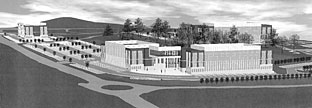
![]()
